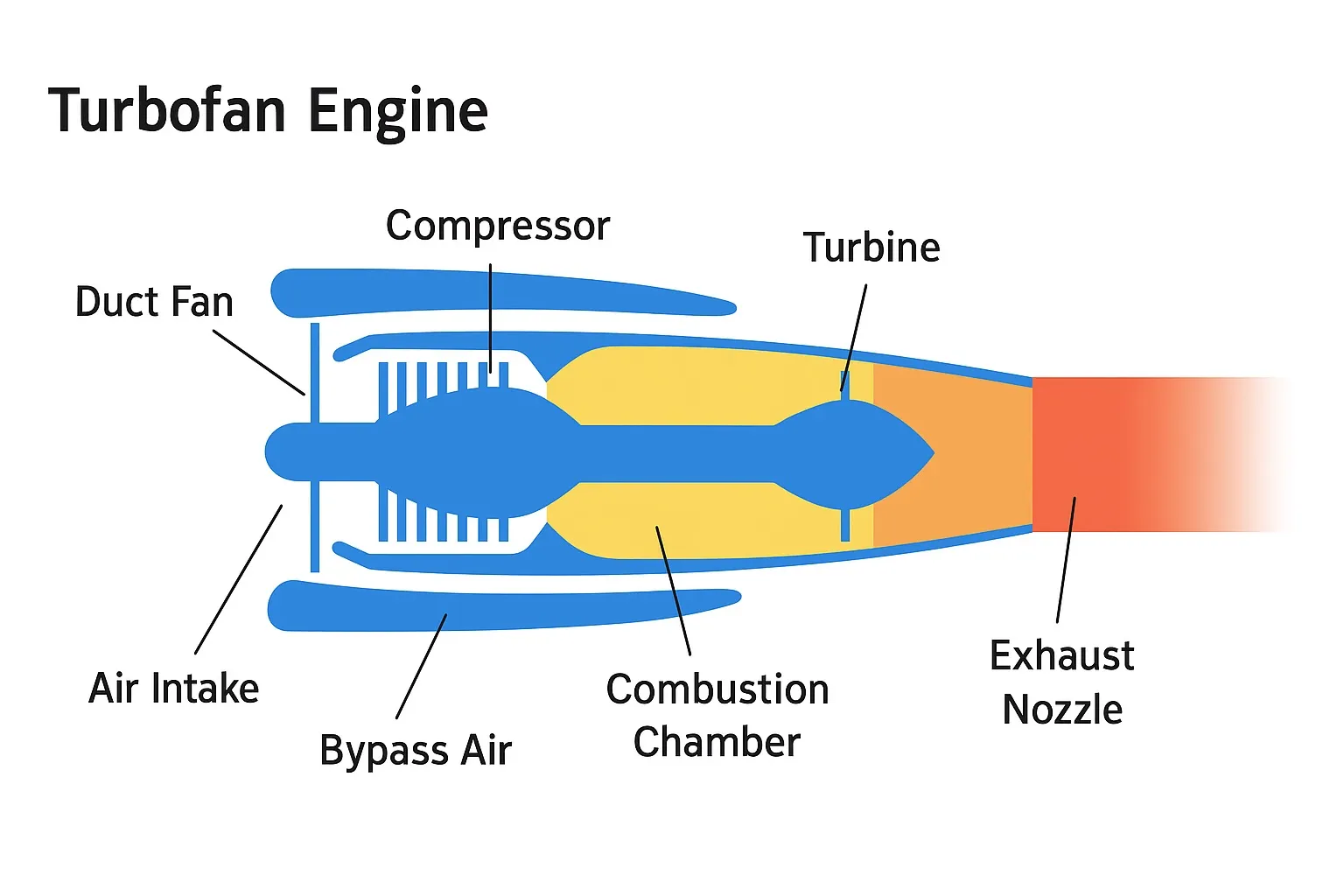DALLAS — You may have heard of sudden loud bangs, vibrations, or even flames shooting out of a jet engine. But what exactly causes this dramatic moment in flight? Why does a jet engine suddenly start behaving like this?
What Is a Compressor Stall?
Think of a compressor like a high-speed, high-pressure air pump that feeds and pushes dense air into the combustion chamber, where it mixes with fuel and ignites. A compressor stall, in the simplest terms, is a breakdown of airflow inside the jet engine.
The air inside no longer flows smoothly; it gets disrupted. As a result, the compressor can’t compress the air efficiently anymore. As the airflow becomes uneven, pressure builds up inside the engine and escapes violently, resulting in those loud bangs and vibrations you sometimes hear.
So, What Does “Disrupted airflow” Actually Mean?
The blades of a compressor work much like the airfoils on a wing. For a wing to generate lift, air needs to hit it at just the right angle; otherwise, an aerodynamic stall occurs. Similarly, inside the compressor section, the air must strike the compressor blades at the correct angle for the compressor to do its job efficiently.
If the angle becomes abnormal, sometimes due to factors like a high angle of attack, the airflow gets disrupted. This disruption can trigger a compressor stall.

What Causes a Compressor Stall?
As mentioned earlier, compressor stall occurs when there is a disruption of airflow inside the compressor section. But what causes this sudden disruption for the engine to behave like this?
Foreign Object Damage
Foreign object damage (FOD) is typically caused by debris ingestion or bird strikes. That kind of debris messes with the airflow inside the engine, sometimes enough to cause a stall. Worst-case scenario, they can even lead to complete engine failure. FOD can also cause significant damage, often requiring costly repairs and resulting in extended aircraft downtime.
Dirty and Worn-Out Components
Sometimes, contaminated or aging compressor parts, usually worn out, can also lead to a compressor stall. Imperfection or erosion of compressor blades disturbs the smooth flow of air through the engine. This is more common in older jets or in aircraft where regular maintenance and overhauls are not carried out correctly.
Extreme Flight Maneuvers
Extreme flight maneuvers can also trigger a compressor stall, as they may create unusual angles of attack that disrupt airflow in the compressor section.. While this is more relevant to military jets or aerobatic aircraft, it’s still a known risk in certain test flights.
For example, the Boeing 777X’s near-vertical takeoff, though executed flawlessly, demonstrates how such maneuvers push the aircraft close to aerodynamic and engine performance limits.
These maneuvers are performed by professional test pilots who ensure that neither an aerodynamic stall nor a compressor stall occurs, thanks to precise calculations and controlled execution.
Sudden Bleed Air Demand or Malfunction
Most commercial aircraft extract air from the compressor section of the engine for various systems, such as cabin pressurization, air conditioning, and anti-ice systems. This extracted air is known as bleed air. If there’s an unusually large and sudden rise in bleed air demand, or a malfunction in the bleed air system, it can disturb the delicate airflow in the compressor section. This disruption may trigger a stall.
How Are Compressor Stalls Handled?
Whenever a compressor stall happens, the first step is to reduce the throttle on the affected engine. Keyword: reduce, not shut down, because most compressor stalls occur during the takeoff phase, which is the most power-intensive phase of a flight.
Losing an engine that can still produce some thrust is far from ideal. After that, the pilots then slowly advance the throttle again. If the compressor doesn’t stall again, it’s good. Otherwise, if the issue persists, the problem is more serious, and the engine is shut down immediately to prevent any damage.
The plane is then diverted to a nearby airport, where the maintenance crew inspects it. In the flight deck, pilots may notice symptoms such as an abnormally high exhaust gas temperature (EGT), loud bangs, and irregular engine RPM; all common indicators of a compressor stall.
Types of Compressor Stalls
There are primarily two types of compressor stalls: Rotating Stall and Individual Blade Stall.
Rotating Stall
A rotating stall is a localized and less severe form of compressor instability. It occurs when one or more small regions of the compressor experience stalled airflow, typically limited to a few adjacent blades or a portion of a compressor stage.
These stalled regions don’t remain stationary; they rotate around the compressor annulus, hence the name "rotating stall." In a rotating stall, the compressor continues to operate and compress air, but its efficiency drops and vibrations may occur. It doesn’t cause a total breakdown of airflow like a surge, but it can lead to further instability if not controlled.
Individual Blade-Level Stall
Stalls also occur at the individual blade or row level, meaning that an entire row or stage of a compressor can experience total airflow separation. This usually happens due to unusual operating conditions, such as a high angle of attack of the incoming air that exceeds the aerodynamic limit of the blade.
While still localized, this type of stall can affect a larger area and cause more noticeable efficiency drops.
Are Compressor Stalls Dangerous?
So, are compressor stalls dangerous? Not really, they sound scary, sure, the loud bangs, vibrations, and temporary loss of thrust can be alarming for passengers.
Fortunately, compared to other in-flight emergencies, compressor stalls are usually manageable and, in many cases, recoverable. Even if recovery isn’t possible and the pilots have to shut down the engine, there’s still no need for panic.
Modern commercial aircraft are designed to fly safely for hours on a single engine, which is more than enough time to reach the nearest airport. So, if you ever experience one during a flight, those sudden noises might be scary, but rest assured: modern aircraft are engineered to handle such situations safely and effectively.
What Is a Compressor Surge?
Compressor stall and compressor surge are almost the same, but they differ in severity. Think of a compressor surge as a more extreme version of a compressor stall. In a surge, the airflow disruption affects the entire engine, unlike a compressor stall, which is usually localized to a few compressor stages.
During a surge, the compressor fails to overcome the pressure downstream, causing the airflow to either stop or reverse direction. This can result in violent expulsions of air, loud bangs, and severe vibrations. It’s like trying to blow more air into a balloon that’s already too full; the pressure pushes the air right back.
In jet engines, this backward rush of air is highly damaging. A surge is severe. It can lead to engine flameouts and, in many cases, force pilots to shut the engine down immediately. If left unaddressed, a surge can damage internal components and lead to mechanical failure.
Preventing Surges and Stalls
However, Modern jet engines are equipped with systems that help prevent stalls and surges from happening in the first place.
Variable Inlet Guide Vanes
These are little adjustable vanes right at the front of the compressor. What they do is control the angle of the air that hits the compressor blades. This helps keep the airflow nice and smooth, which allows for reducing the risk of a compressor stall even during extreme flight conditions.
A similar principle is seen in fighter jets like the F-15, which use variable engine intakes to optimize airflow into the engine during steep climbs or high-angle-of-attack maneuvers. Even though the tech works differently, the idea’s the same: ensuring the engine maintains smooth, steady airflow regardless of the conditions.
Bleed Air valves
These valves open up to release excess compressed air from the engine during certain phases of flight, such as throttle transitions or descent. By doing so, they relieve pressure build-up inside the compressor, helping to prevent a surge and maintain stable airflow throughout the engine.
Final Take
Compressor stalls may sound dramatic, but the loud bangs and strong vibrations can startle passengers; however, they are rare and generally manageable events, especially in modern commercial aircraft.
All of this is further reassured by the fact that modern-day jet engines are equipped with systems that prevent a stall from occurring in the first place.
.webp)



